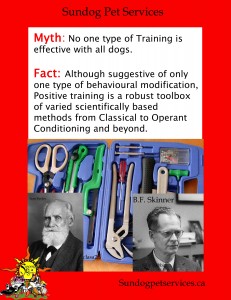
Dog owners, and even novice trainers are often befuddled by all the information about on dog training. The Science is Misdirected, obfuscated or misunderstood. Some professionals doll out the misinformation as fact. A lot of solid, scientifically sound information often getting overrun by the din of the poor. One of these misunderstandings is over one single line; “There is no one way to train dogs.” The implication being one group of trainers uses only one method to train dogs, while the other side uses all methods. While Force Free and/or Positive Training (FF/PT) methods suggest only use of one method available in modern dog training, in practice and theory, Balanced Training seems to use only a small sliver of available tools used in 21st century dog training.
Modern Dog Training
Previous centuries did use the science of Training, but not with the nomenclature of the science. Folk knowledge was passed from generation to generation. Modern dog training uses Operant Conditioning (“If I do X, then I get/avoid Y.”) and Classical Conditioning (“If X happens, then Y follows”). Also available and understood by good practitioners is management (enuring dogs can’t rehearse undesired behaviours) and antecedent arrangement (ie. ensuring the environment isn’t overpowering training). They are not always mutually exclusive.
Management and Antecedent arrangement are often fundamental to make Operant conditioning work well. Not removing chances to perform old “bad” behaviours and not dealing with competing motivations sets the dog up for failure. Asking compulsive gamblers to attend gamblers anonymous meetings in the middle of a crowded casino is a recipe for failure. Asking a chronic shoe chewer to play with a different toy while a flock of shoes is around is also a recipe for failure. Throwing an arachnophe into a dense, spider filled jungle, without preparation before hand, is a recipe for failure. Making a dog encounter a stressor to stop a reaction is a recipe for failure.
Classical conditioning always occurrs in the background of operant conditioning – (“Pavlov is always sitting on your shoulder.” – Bob Bailey). Ask a dog to do something; they get it right, and get a good thing starts adjusting emotional states positively. They begin to think the asking means something good will happen. The opposite is aslo true. If asked, they don’t perform, and something bad happens, association with that bad thing can occur (or sometimes with the person asking, or some other thing in the environment – fear is fickle!). Understanding science helps counter these effects or use them advantageously.
The Divide
Good, competent Force Free/Positive Reinforcement practitioners use all of these mentioned and understand when to use one over another. They do not rely on just one portion or method. They do however, avoid the use of aversives in operant conditioning. Meaning they do not employ or avoid fear, intimidation or pain. Mostly this is an ethical choice, and increasingly is being backed by solid, current science; although pain and fear may work, the side effects can be to detrimental, and are avoided.
Balanced training uses operant conditioning. Whether just by the use of the associated language, misunderstanding of scientific fact, or from lack of knowledge, little outward acknowledgement of other modern training principles. When dealing with most aggression, the answer is “deal with the behaviour.” “If we don’t do X, the dog will die”/”If we don’t use X, we won’t get a good recall” In order to fix the behaviour, they need the behaviour to happen. This means putting the dog into stressful situations, then correcting the dog; corrections often of an aversive, punitive nature. “Pavlov is always sitting on your shoulder” here means dogs can potentially associate aversives with the trainer, the stressful trigger, or something completely unrelated instead of the actual behaviour. This does not mean that balanced trainers do not use food, fun, play to achieve some of their goals. They seem to use operant conditioning without apparent consideration of the possible side effects. Arguments against management and antecedent arrangements are often prevalent in balanced training.
Comparisons
“You can’t arrange real life” is sometimes true; but as much as possible practitioners can seek out situations where arrangement is possible until the dog understands – then the situations become manageable by the dog in time. Learning how to deal with a problem with more than one tool available is what any good trainer in the future will do. There are times when management is necessary, and sometimes the only recourse such as walking a truly aggressive dog with a poor mouth only with a muzzle. Trying to deal with just the aggression, with no management is poor, and dangerous, practice. Arrangement ensures success is more likely with both operant and classical methods.
Eliminating aversives does not make operant conditioning weaker, but increases the potential welfare of the animal by eliminating negative shifts in emotional states.
What does it all mean then?
You take yourself to the doctor. She mentions that the cut in your arm is infected. She elects and strongly encourages amputation! This will ensure that the infection doesn’t spread. You will be back at work in a few days with no other physical harm. Antibiotics or possible psychological effects are mentioned. We all know that this is silly, but the analogy is not far off from what some people experience.
A broad base approach proves there is only one way to train dogs – Force Free and Positive Reinforcement Training currently, while a narrower approach encompasses dangers and potential negative welfare states for dogs. Systematic, scientifically sound training with standard procedures for the most common behaviour modification is essential. Eliminating, or managing potentially harmful outcomes increases positive welfare states.
Trainers become trainers partly because they want to be good to dogs. Lacking correct, science based learning though, this can be corrupted or misused. When this happens, welfare can suffer; counter to what was actually intended in the first place!
So what are owners to do? Ask questions. Make sure clear, concise answers are given. Something akin to this. Currently no legal regulatory body governing exists for dog trainers; anyone can hang out a shingle and do nearly anything to your dog. Advocate for your dog; if you don’t like what is happening, or you wouldn’t practice that way yourself or on any other animal or child, stop the training.


